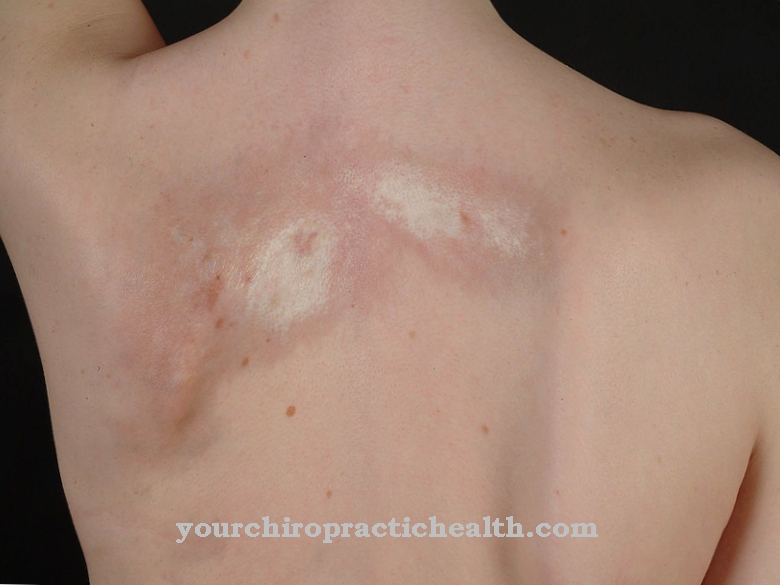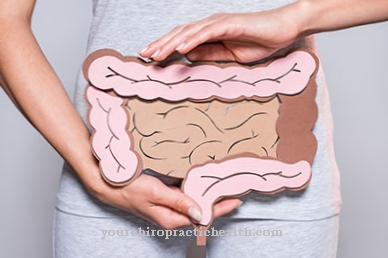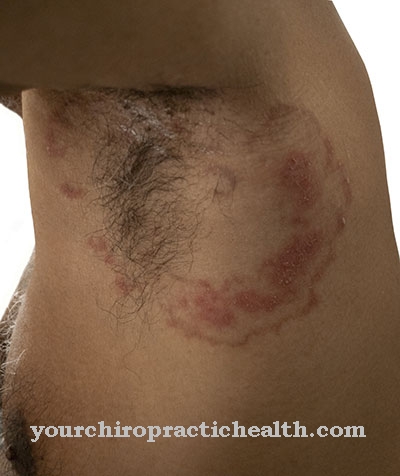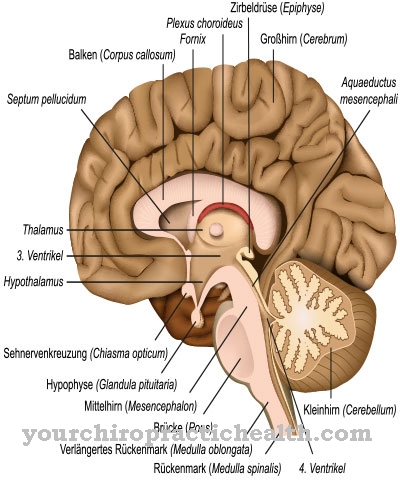Under one heparin-induced thrombocytopenia is understood to mean a disease that can occur after the administration of heparin. The number of platelets in the blood drops to below 50 percent of the normal value.
What is heparin-induced thrombocytopenia?

© tunedin - stock.adobe.com
Heparin-induced thrombocytopenia (HIT) represents a complication in the treatment with heparin. Heparin is a standard medical drug for anticoagulation (inhibition of blood clotting). The administration of the active ingredient is intended to counteract a thrombosis (blood clot).
As a rule, therapy with heparin is considered useful. In some cases, however, a paradoxical effect of the agent can occur a few days after administration. This means that the platelets (platelets) clump together, causing the number of platelets in the blood to decrease.
In the further course there is a heparin-related blood platelet deficiency, also known as thrombocytopenia or thrombopenia. Those affected are at increased risk of developing a blood clot. Overall, around ten percent of all treated patients suffer from heparin-induced thrombocytopenia.
causes
In medicine, a distinction is made between two different forms of heparin-induced thrombocytopenia. They are called HIT Type I and HIT Type II and have various causes. In both cases, thrombocytopenia only occurs after the administration of the heparin.
The trigger for heparin-induced thrombocytopenia is an interaction between the blood platelets and the heparin. It is believed that the heparin is responsible for inhibiting an important enzyme, which causes the platelets to activate and clump more quickly, which in turn leads to faster consumption.
However, HIT type I is considered harmless, as only a slight lack of blood platelets occurs and the complication disappears on its own after a few days. Because the platelets do not normally go below 80,000 / µl, no treatment is required. The heparin-induced thrombocytopenia type II is due to a defense mechanism.
The human immune system creates antibodies against the heparin in the blood, which in turn leads to clumping. There is a risk that the platelet count will drop below 50 percent of normal. If the blood vessels are blocked as a result, there is a risk of significant health problems such as a pulmonary embolism, a stroke or a heart attack.
The risk of HIT type II increases with the duration of heparin treatment. If the doctor does not administer the heparin for more than five days, complications rarely occur. The level of the heparin dose also plays an important role in the development of HIT type II.
Symptoms, ailments & signs
The symptoms that occur with heparin-induced thrombocytopenia depend on whether it is HIT type I or HIT type II because the two forms take on different degrees. Most patients with Type I HIT do not notice anything. After a few days, the fault is eliminated.
In the context of heparin-induced thrombocytopenia type II, however, the number of blood platelets decreases significantly, which is noticeable about 5 to 14 days after the start of treatment. If the heparin is administered repeatedly, the antibodies form more quickly, so that they show up after one or two days. Due to the sharp drop in the number of blood platelets, blood clots can form, which as an embolism trigger, among other things, a heart attack.
The leg veins are also severely affected because the thromboses damage the tissue that is supplied by arteries. In extreme cases, the affected limb may even have to be amputated. A pulmonary embolism, in which a pulmonary artery is blocked, is also possible with pain, shortness of breath and fainting. Another life-threatening complication is a stroke. Sometimes the tissue near the heparin injection site also dies.
Diagnosis & course
Suspicion of heparin-induced thrombocytopenia usually arises when the platelet count drops after heparin therapy, which is particularly the case with HIT type II. One of the most important diagnostic methods is a blood test, which shows the lack of platelets.
The blood sample can also be used to determine heparin-specific antibodies, which is often done with the ELISA method. Another test method is the HIPA method. Here, heparin is administered to the patient's blood platelets in order to control any clumping.
Because some blood disorders have symptoms similar to heparin-induced thrombocytopenia, a differential diagnosis is also important.
It is important to rule out diseases such as this seminated intravascular coagulation. The course depends on the type of heparin-induced thrombocytopenia that occurs. While type I HIT is mostly harmless, type II HIT often triggers venous thrombosis, which leads to further serious complications.
Complications
This disease can lead to various ailments and complications. In most cases, however, it goes unnoticed by the patient, with no particular symptoms occurring afterwards. The disease usually goes away on its own after just a few days. However, if there is a sharp decrease in blood platelets, symptoms can occur about a week later.
This leads to blood clots, which significantly increases the risk of a heart attack. In the worst case, the affected person can also die from a heart attack. Tissue throughout the body is also damaged, including the extremities. Here, extremities can sometimes die off completely, whereby an amputation may be necessary.
It is not uncommon for shortness of breath and loss of consciousness to occur, whereby the patient can also suffer injuries or a fall. The heart attack can also lead to irreversible consequential damage if it is not treated immediately. The treatment takes place with the help of medication and usually leads to quick relief of the symptoms. In most cases, early treatment will not reduce life expectancy.
When should you go to the doctor?
If the feeling of illness persists, a doctor should be consulted. If there are changes in the blood circulation, heart problems or abnormalities in the blood circulation, a doctor's visit is necessary. Pain in the body that sets in or spreads for no apparent reason should be examined and treated. Consultation with a doctor is required as soon as the patient wants to take medication because of the pain.
There are often side effects that must be clarified in advance and in good time. Greater vigilance is required in the event of breathing disorders. Any shortness of breath should always be examined by a doctor. If breathing stops or changes in the heartbeat, a doctor is required. If the person concerned suffers from anxiety or panic attacks, he should see a doctor. Impairment of consciousness should also be investigated.
An emergency doctor must be called in the event of a failure. Numbness on the skin or sensitivity disorders must be clarified by a doctor. If the sensory disturbances occur in the extremities or if there are unsteady gait or mobility problems, a doctor should be consulted. Consult a doctor if you experience increased stress, a decrease in normal performance or problems with concentration. Further research is necessary so that a cause can be found.
Doctors & therapists in your area
Treatment & Therapy
If the suspicion of heparin-induced thrombocytopenia is confirmed, rapid medical treatment is necessary. It may be necessary not to wait for all laboratory tests to start therapy in order to gain valuable time. The most important part of the therapy is the discontinuation of the heparin and the administration of another drug with a similar effect.
This is mostly the drug argatroban. This lowers blood clotting, but does not trigger thrombocytopenia. Other medicines that may be considered are lepirudin and danaparoid. In addition, no heparin may enter the patient's organism in any other way. The agent can also be found in douches, ointments or catheters.
Outlook & forecast
The prognosis of heparin-induced thrombocytopenia depends on the type. There are basically two types of the disease. Type I heparin-induced thrombocytopenia is harmless and only characterized by a slight decrease in the platelet count. It usually runs without symptoms and heals on its own. Treatment is therefore not necessary.
In contrast, the prospects for heparin-induced thrombocytopenia of type II are much worse. The platelet count decreases very quickly here because antibodies against the heparin-protein complexes are formed. While the platelet count in type I rarely falls below 100,000 / µl, in type II it can fall below this value extremely. In very rare cases, values even lower than 20,000 / µl are possible.
In spite of the low platelet count, however, there is usually no major bleeding, but even increased formation of thrombi, because the antibodies activate the platelets. It is an acutely life-threatening condition that requires immediate emergency medical help. The administration of heparin must be discontinued immediately and replaced with other anticoagulants.
The complications that occur in heparin-induced thrombocytopenia are almost exclusively due to the secondary effects of the thrombi. Death can be caused by a pulmonary embolism or a heart attack. About 30 percent of all heparin-induced thrombocytopenias of type II are fatal.
prevention
To prevent heparin-induced thrombocytopenia, it is possible to administer low molecular weight heparin instead of conventional heparin. In this way the risk of HIT is significantly reduced. In addition, the duration of the therapy should be as short as possible.
Aftercare
With this disease, the person affected should first and foremost consult a doctor as soon as possible so that there are no further complications or other complaints. The measures and the possibilities of follow-up care for this disease are usually very limited, so that the early detection and treatment of the disease is in the foreground.
The earlier the person concerned visits a doctor, the better the further course of the disease is usually, so that a doctor should be contacted as soon as the first symptoms and signs of the disease appear. In most cases, the disease is treated by stopping the offending drug. However, the person concerned should only stop this after medical advice and take another medication.
When taking medication, the correct dosage and regular intake must always be ensured in order to permanently alleviate the symptoms. Furthermore, most of those affected are dependent on the help and support of their own family and friends in their everyday lives. Loving and intensive conversations also have a positive effect on the course of the disease and can prevent psychological upsets or depression.
You can do that yourself
If heparin-induced thrombocytopenia is suspected, the most important action taken is to see a doctor. It is a medical emergency that requires medical intervention.
First, the triggering drug must be discontinued and another drug with a similar effect must be prescribed. Usually the drug argatroban is prescribed, which lowers blood clotting and regulates blood pressure. The patient must ensure that heparin does not enter the organism in any other way.
So rinses, ointments or creams must be checked before use. Catheters can also contain the substance and should be checked before use. Should there be any further complaints, the doctor must be informed immediately. The same applies to side effects and interactions caused by the prescribed drugs.
Further self-help measures are limited to protecting the body and especially the cardiovascular system. This is achieved by avoiding strenuous physical activity in the first few weeks after the incident.The patient should also avoid stress and get a good night's sleep. A balanced diet also contributes to a quick recovery after heparin-induced thrombocytopenia.


.jpg)



.jpg)




















